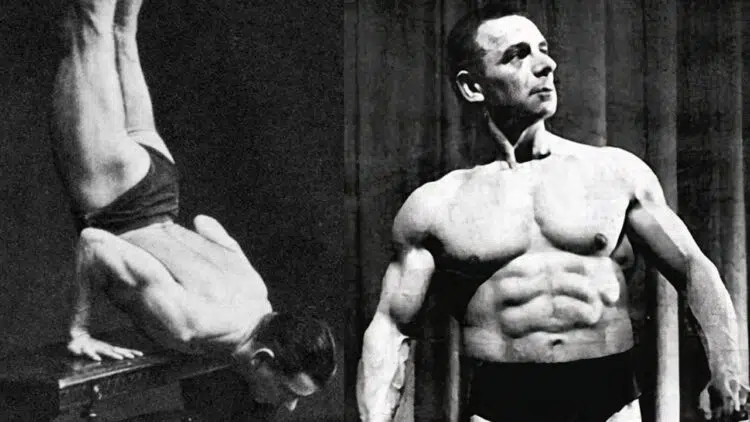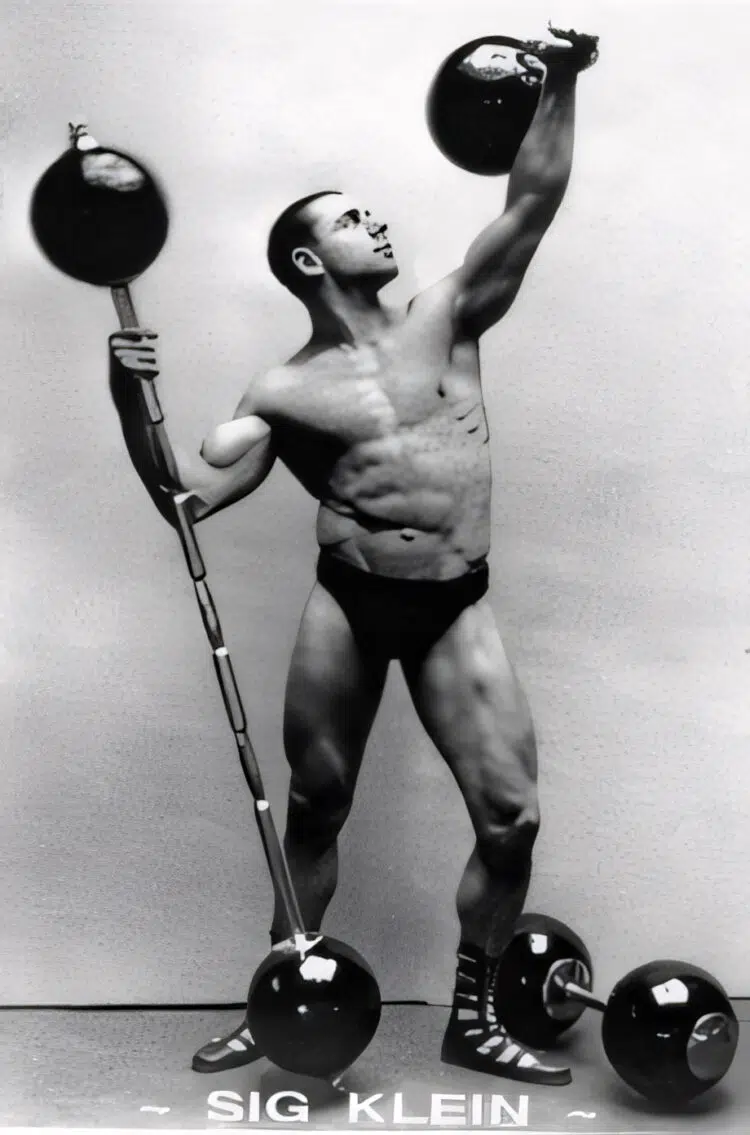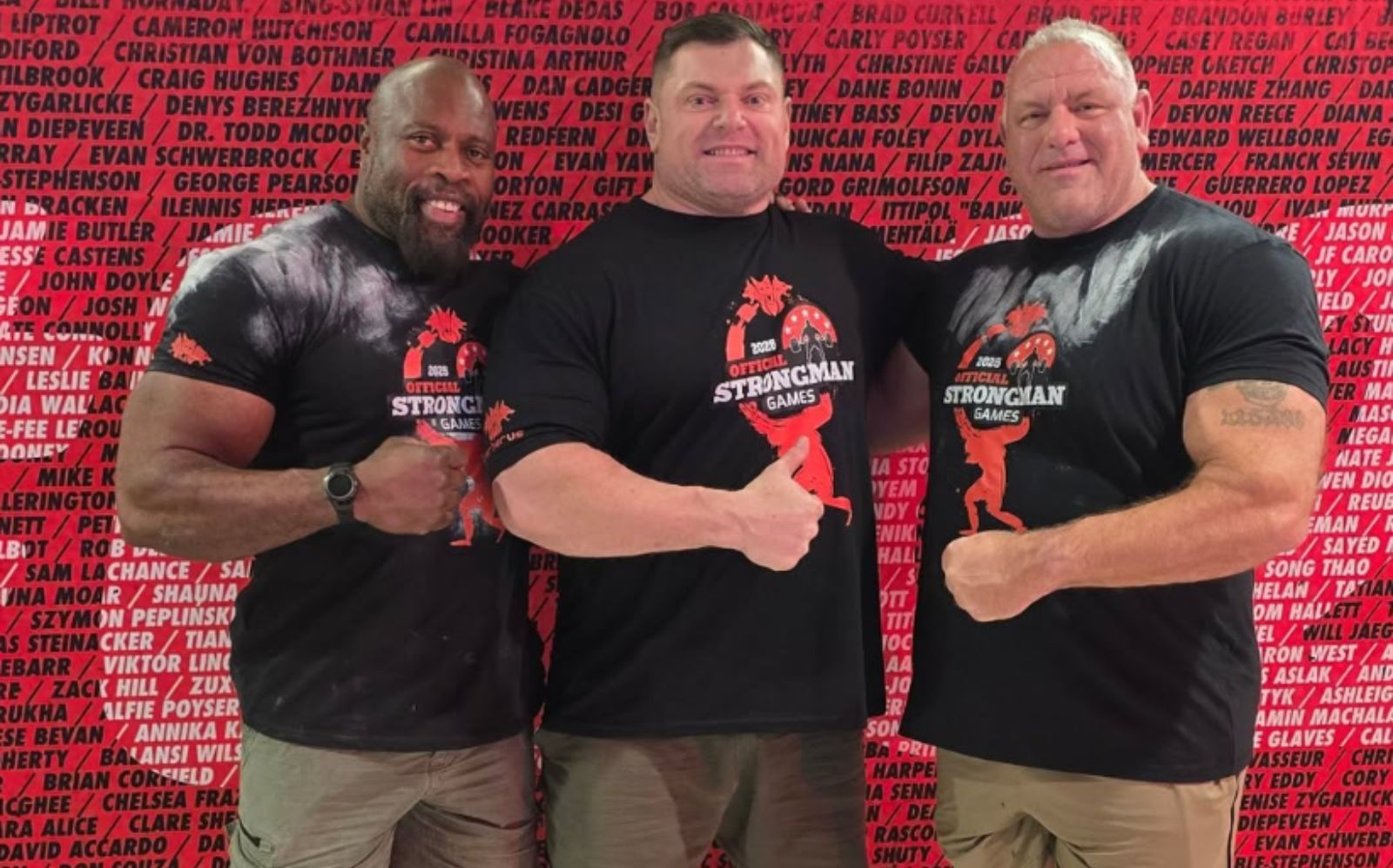It’s generally accepted that bodybuilding officially began in the late 1800s with the rise in popularity of Eugene Sandow. This famed strongman and physical culturist is often known as “the father of modern bodybuilding,” and Mr. Olympia winner’s trophies bear Sandow’s likeness.
However, like all sports, bodybuilding has evolved since it started, and the physiques of the past are very different from those of today. Consequently, there are several recognized bodybuilding eras. Each one had its champions and stars and often featured different training and nutritional philosophies.
For example, modern bodybuilders mostly use split routines to build muscle, and anabolic steroid use is common in competitive bodybuilding. In contrast, bronze and silver-era bodybuilders didn’t have access to performance-enhancing drugs, and they relied more on full-body workouts to sculpt their physiques.
Siegmund (Sig) Klein (April 10, 1902 – May 24, 1987) was active during the late bronze and early silver eras of bodybuilding. He was very muscular and strong for the time and ran a popular New York gym for many years.
Klein was also a celebrated publisher and author, sharing his training knowledge with his army of followers via numerous courses, books, and magazines.
In this article, we examine Sig Klein’s classic Full Body Workout Program from the 1940s, which relies on simple hard work to build muscle the old-school way.
Level Up Your Fitness: Join our 💪 strong community in Fitness Volt Newsletter. Get daily inspiration, expert-backed workouts, nutrition tips, the latest in strength sports, and the support you need to reach your goals. Subscribe for free!
Sig Klein’s Training Principles

Like many successful bodybuilders, both old and new school, Sig Klein had a set of principles that he believed should form the framework of any effective training program. While Klein’s principles may seem pretty straightforward today, they were considered cutting-edge at the time.
Sig Klein’s training principles included:
Strict Form Always
Klein was a stickler for proper training technique. He warned against lifting heavy weights with poor form, as he thought that doing so made workouts less effective and potentially dangerous. According to Sig Klein, if you couldn’t lift and lower a weight with complete control, it was too heavy.
From a modern perspective, this echoes what we call the mind-muscle connection. You can’t develop a muscle you cannot feel working, and the best way to achieve this is by lifting with purpose and not cheating the weight up with momentum.
Progress Slowly
Sig Klein understood the concept of progressive resistance, where workouts gradually get harder to increase muscle and strength. However, he preferred slow, small increases rather than big jumps in weight. As far as Klein was concerned, patience was an important virtue for bodybuilders.
With that in mind, he’d probably have been a fan of microloading, which is the ultimate slow-burn way to build muscle and strength.
Be Dedicated
Rome wasn’t built in a day, and nor were old-school muscular physiques. Many modern lifters want to get huge overnight, which partly explains why so many turn to steroids.
Klein understood that building muscle naturally takes many years, and often stressed the importance of long-term dedication. For Klein, bodybuilding was a lifestyle and not a casual pastime. He also appreciated the health-boosting benefits of working out and the importance of maintaining muscle mass as he aged.
Positive Mental Attitude
According to Klein, almost anything is possible if you’ve got a positive mental attitude. It’s easy to blame lack of time or poor genetics for your training woes but, if you think positively, many drawbacks become strengths. So, take a leaf out of Sig Klein’s book, and think big to get big!
Train Hard but Rarely to Failure
Old-school bodybuilders seldom trained to failure. Instead, they usually left 1-3 reps in reserve at the end of each set. This more conservative approach to training meant that they recovered better between workouts. In addition, in those days, many lifters had manual labor jobs, and couldn’t afford to go to work exhausted.
Full-Body Workouts
Split routines were virtually unheard of in Sig Klein’s time. As far as he was concerned, full-body workouts were the only way to train. Klein encouraged his followers to do three full-body workouts per week, each one lasting no more than an hour or so. He also emphasized freeweights and compound exercises.
The Sig Klein Full-Body Workout Program
Sig Klein prescribed the following program to most of the beginners joining his New York gym. Comprising two workouts (A and B), he recommended three workouts per week, alternating the A and B programs session by session, i.e.,
Week 1
- Monday – workout A
- Wednesday – workout B
- Friday – workout A
Week 2
- Monday – workout B
- Wednesday – workout A
- Friday – Workout B
Week 3
Level Up Your Fitness: Join our 💪 strong community in Fitness Volt Newsletter. Get daily inspiration, expert-backed workouts, nutrition tips, the latest in strength sports, and the support you need to reach your goals. Subscribe for free!
- Monday – workout A
- Wednesday – workout B
- Friday – workout A, etc.
Trainees began by doing 12-15 reps per exercise, gradually increasing the load and reducing the reps until they were doing eight reps per set. This would take several months of consistent training, resulting in significant increases in strength and muscle mass.
However, abs exercises were typically performed for higher reps as these were bodyweight movements.
Sig Klein Full-Body Workout A
| # | Exercises | Sets | Reps | Recovery |
| 1 | Decline Sit-Up | 2-4 | 15-20 | 1-2 minutes |
| 2 | Two Arm Curl | 2-4 | 8-15 | 1-2 minutes |
| 3 | Calf Raise | 2-4 | 8-15 | 1-2 minutes |
| 4 | Two Arm Pullover | 2-4 | 8-15 | 1-2 minutes |
| 5 | Leg Raise | 2-4 | 15-20 | 1-2 minutes |
| 6 | Two-Arm Bench Press | 2-4 | 8-15 | 1-2 minutes |
| 7 | Side Bend | 2-4 | 15-20 | 1-2 minutes |
| 8 | Deep Knee Bend | 2-4 | 8-15 | 1-2 minutes |
| 9 | Two-Arm Overhead Press | 2-4 | 8-15 | 1-2 minutes |
Sig Klein Full-Body Workout B
| # | Exercises | Sets | Reps | Recovery |
| 1 | Deadlift | 2-4 | 8-15 | 1-2 minutes |
| 2 | Decline Sit-Ups | 2-4 | 8-15 | 1-2 minutes |
| 3 | Reverse Curl | 2-4 | 8-15 | 1-2 minutes |
| 4 | Hanging Leg Raise | 2-4 | 15-20 | 1-2 minutes |
| 5 | Shoulder Shrug | 2-4 | 8-15 | 1-2 minutes |
| 6 | Criss Cross Standing | 2-4 | 15-20 | 1-2 minutes |
| 7 | Dumbbell Bench Press | 2-4 | 8-15 | 1-2 minutes |
| 8 | Two Dumbbell Curl | 2-4 | 8-15 | 1-2 minutes |
| 9 | Dumbbell Leg Curl | 2-4 | 8-15 | 1-2 minutes |
| 10 | Dumbbell Leg Extension | 2-4 | 8-15 | 1-2 minutes |
A Modern Trainer’s View of Sig Klein’s 1940s Workout Program
As a veteran personal trainer, I lost count of how many workout programs I’ve written over the years. I’m sure it’s thousands. I’ve also taught strength training program design to hundreds of prospective fitness professionals.
Related: Full-Body Workout Plan – Design Your Own + Sample Workouts
With all this experience behind me, I’m well-positioned to offer an informed opinion on the merits of Sig Klein’s full-body workout plan.
So, with all that in mind, here are my observations regarding this old-school training program. Needless to say, mine is a modern perspective based on information that Sig Klein may not have been aware of.
The Good
Minimal Equipment Required – neither the A nor the B workout requires much more than a barbell, dumbbells, and a bench. No bench? No problem – you can do floor presses instead. This low-tech approach means that even home exercisers can follow this program, although Klein actually prescribed it to new members of his New York gym.
Lots of Compound Exercises – there are very few isolation or single-joint exercises in either of Sig Klein’s workouts. This ensures that lifters get the most bang for their buck and that the workout builds strength as well as muscle mass. It also helps keep the volume down, making the workout more time-efficient and practical.
Appropriate Sets, Rep, and Rest Periods – 8-15 is a popular rep range among modern bodybuilders. While you can build muscle with more reps, 8-15 has proven to be effective. The inter-set rest periods are also appropriate for hypertrophy training.
Klein’s use of these ranges predates most research on effective sets and reps. So, either by accident or design, Sig Klein created a scientifically sound program, even by today’s standards.
An Emphasis on Long-Term Progression – gradual progression is critical for bodybuilding success. Klein’s program has this built in as trainees are encouraged to lift heavier weights for lower reps as the months pass. Progressive overload is one of the most important drivers of bodybuilding success.
Deadlifts! – workout B starts with a couple of sets of deadlifts, arguably the best barbell exercise of them all. In fact, during this time, deadlifts were known as health lifts and celebrated for their ability to build strength and muscle mass. Almost any workout with deadlifts in it is a good workout IMO.
The Not-So-Good
Exercise Order – modern strength training programs are usually front-loaded so the most difficult and tiring exercises are done early on. This makes the best use of your training energy and time. Subsequent exercises should then flow logically from these initial movements.
However, the exercise order in Sig Klein’s workouts appears random. While this isn’t a huge issue, it could mean that the exercises at the end of the workouts are harder or less effective than they should be as you’ll be pretty tired when you reach them.
Potential Muscle Imbalances – other than biceps curls and pullovers, there are no upper-body pulling exercises in either of Sig Klein’s workouts. Consequently, the lats go largely untrained, resulting in potential muscle imbalances. This can be remedied by adding pull-ups to one workout and bent-over rows to the other.
Too Few Leg Exercises – each workout contains 9-10 exercises, but only a couple involve your legs. Personally, I’d prefer to see more leg exercises as, after all, the lower body makes up close to 50% of your total muscle mass. Some lunges, leg presses, or step-ups would be a great addition.
Also, deep knee bends, which appear toward the end of workout A, are a bodyweight exercise. As such, they are a little out of place and arguably too easy to build muscle. A barbell squat or dumbbell goblet would be a much better option.
Conclusion
At close to 80 years old, Sig Klein’s Full Body Workout Program is a classic of the bronze/silver eras of bodybuilding. Simple yet challenging, these workouts require minimal training equipment and have the potential to build muscle size and strength.
However, by today’s standards, they’re both somewhat outdated, and modern training methods and program design principles mean that there are probably better workouts around.
That said, if you want to try an old-school workout, the classic 20-rep breathing squat program is a great choice as it avoids many of the issues you’ll find in Klein’s workouts.
You could also try the famous Sig Klein strength challenge, which involves doing 12 non-stop reps of dumbbell clean and presses with a pair of 75-pounders (34kg). This challenge delivers an intense full-body workout that most lifters will need to work up to.
At the time, Klein stated that only a few people could meet this challenge. But, of course, Sig Klein was one of them!









